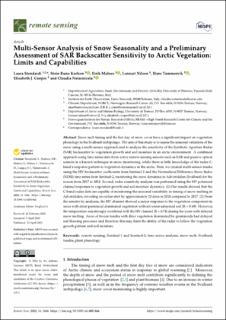| dc.contributor.author | Stendardi, Laura | |
| dc.contributor.author | Karlsen, Stein Rune | |
| dc.contributor.author | Malnes, Eirik | |
| dc.contributor.author | Nilsen, Lennart | |
| dc.contributor.author | Tømmervik, Hans | |
| dc.contributor.author | Cooper, Elisabeth J. | |
| dc.contributor.author | Notarnicola, Claudia | |
| dc.date.accessioned | 2022-04-20T07:00:49Z | |
| dc.date.available | 2022-04-20T07:00:49Z | |
| dc.date.created | 2022-04-19T13:29:36Z | |
| dc.date.issued | 2022 | |
| dc.identifier.issn | 2072-4292 | |
| dc.identifier.uri | https://hdl.handle.net/11250/2991424 | |
| dc.description.abstract | Snow melt timing and the last day of snow cover have a significant impact on vegetation phenology in the Svalbard archipelago. The aim of this study is to assess the seasonal variations of the snow using a multi-sensor approach and to analyze the sensitivity of the Synthetic Aperture Radar (SAR) backscatter to vegetation growth and soil moisture in an arctic environment. A combined approach using time series data from active remote sensing sensors such as SAR and passive optical sensors is a known technique in snow monitoring, while there is little knowledge of the radar C-band’s response pattern to vegetation dynamics in the arctic. First, we created multi-sensor masks using the HV backscatter coefficients from Sentinel-1 and the Normalized Difference Snow Index (NDSI) time series from Sentinel-2, monitoring the snow dynamics in Adventdalen (Svalbard) for the season from 2017 to 2018. Second, radar sensitivity analysis was performed using the HV polarized channel responses to vegetation growth and soil moisture dynamics. (1) Our results showed that the C-band radar data are capable of monitoring the seasonal variability in timing of snow melting in Adventdalen, revealing an earlier start by approximately 20 days in 2018 compared to 2017. (2) From the sensitivity analyses, the HV channel showed a major response to the vegetation component in areas with drier graminoid dominated vegetation without water-saturated soil (R = 0.69). However, the temperature was strongly correlated with the HV channel (R = 0.74) during the years with delayed snow melting. Areas of frozen tundra with drier vegetation dominated by graminoids had delayed soil thawing processes and therefore this may limit the ability of the radar to follow the vegetation growth pattern and soil moisture. View Full-Text remote sensing; Sentinel-1 and Sentinel-2; time series analysis; snow melt; Svalbard; tundra; plant phenology | en_US |
| dc.language.iso | eng | en_US |
| dc.rights | Navngivelse 4.0 Internasjonal | * |
| dc.rights.uri | http://creativecommons.org/licenses/by/4.0/deed.no | * |
| dc.title | Multi-Sensor Analysis of Snow Seasonality and a Preliminary Assessment of SAR Backscatter Sensitivity to Arctic Vegetation: Limits and Capabilities | en_US |
| dc.title.alternative | Multi-Sensor Analysis of Snow Seasonality and a Preliminary Assessment of SAR Backscatter Sensitivity to Arctic Vegetation: Limits and Capabilities | en_US |
| dc.type | Peer reviewed | en_US |
| dc.type | Journal article | en_US |
| dc.rights.holder | © 2022 by the authors | en_US |
| dc.description.version | publishedVersion | en_US |
| cristin.ispublished | true | |
| cristin.fulltext | original | |
| cristin.qualitycode | 1 | |
| dc.identifier.doi | 10.3390/rs14081866 | |
| dc.identifier.cristin | 2017572 | |
| dc.source.journal | Remote Sensing | en_US |
| dc.relation.project | EU/869471 | en_US |
| dc.relation.project | Norges forskningsråd: 269927 | en_US |
| dc.relation.project | Norges forskningsråd: 230970 | en_US |
| dc.subject.nsi | VDP::Zoologiske og botaniske fag: 480 | en_US |
| dc.subject.nsi | VDP::Zoology and botany: 480 | en_US |

